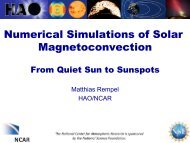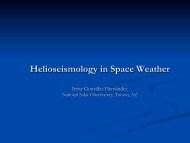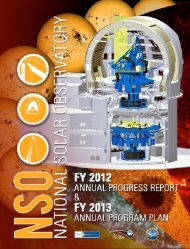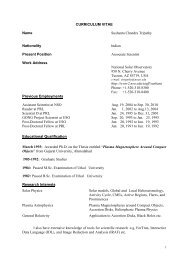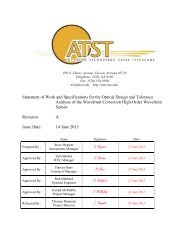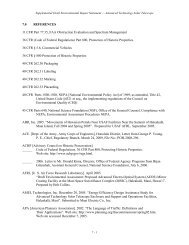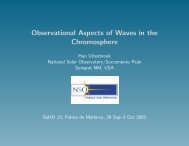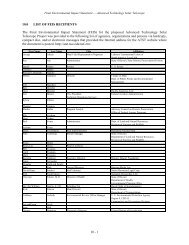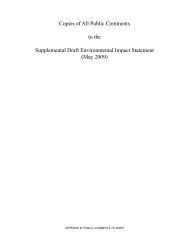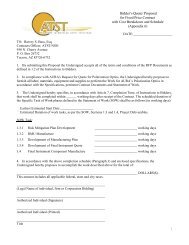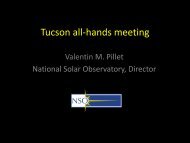F2 - ATST
F2 - ATST
F2 - ATST
Create successful ePaper yourself
Turn your PDF publications into a flip-book with our unique Google optimized e-Paper software.
Cultural Surveys Hawai‘i Job Code: HALEA 2Summary and RecommendationsSection 8 Summary and RecommendationsIt is clear that Mauna Haleakalā, from past to present, is a significant part of traditionalHawaiian culture and that to the majority of the Native Hawaiian community who participated inthis process, the construction and operation of the proposed <strong>ATST</strong> presents a negative impact onthe summit of Haleakalā. The mountain and summit play significant roles in traditional Hawaiianlore and epic battles between the elements and the gods. From traditional times to the presentday, kanaka maoli (Native Hawaiians) ascend the mountain to engage in ceremonial activitieseither within a group setting (e.g. with hula halau or to observe the Makahiki) or in solitude. Themagnificence and serenity of the mountain is voiced not only from Native Hawaiian people, butfrom non-Hawaiians as well. Narratives from non-Hawaiians as far back as the first missionaryaccounts of their first view and ascent of the mountain attest to the majestic presence ofHaleakalā (see Section 3.3 Early Historic Era to the Late-1800’s.). This is clearly felt into thepresent time as visitors to Maui continue to make the trek to the summit to greet the day.It is apparent that significant immediate and cumulative impacts are expected by the proposed<strong>ATST</strong> facility atop Haleakalā. Immediate and short-term impacts to the summit of Haleakalāwould be associated with activities directly related to the construction of the facility itself, aswell as the potential impacts to the surrounding infrastructure during the construction phase (i.e.soil and construction staging areas and/or increased use of the roadways). For the kanaka maoli,the physical excavation of the cinder itself is seen as a descration of the kinolau or body of Peleherself (see Section 5 Scoping Meetings and Section 106 Testimony). There are disagreementswithin the community as to the degree to which this type of impact can be mitigated, if at all.Steps toward preservation and education with regard to Native Hawaiian cultural beliefs andsense of place have been put forth in “Ku I Ka Mauna” Upright At the Mountain. CulturalResources Evaluation for the Summit of Haleakalā (Maxwell 2003), a document prepared as apart of the Haleakalā High Altitude Observatory Site Long Range Development Plan (KCEnvironmental 2005)To limit the assessment of the cumulative and long-term impacts of the proposed <strong>ATST</strong>undertaking to the 18.166-acre area would be difficult, as the overall size and color of proposedfacility would have a more wide-ranging effect and need to take into account the whole of thesummit and crater area. Based on the testimony presented by the community, there is a necessityfor an unimpeded viewplane from mountain to ocean, particularly in the context of ceremonialactivities at the east and west ahu within the HO parcel itself. It is clear that the height and colorof the proposed facility would impede the viewplane and is seen by some as a personal affront totheir cultural beliefs. From a traditional Hawaiian viewpoint, the unaesthetic nature of the facilityhas led to further objections to the observatory as an additional “eye sore” to the summit area. Itwould compound the negative impacts of the already existing facilities.The anticipated negative impacts to Haleakalā that would result from the construction andday-to-day use of the <strong>ATST</strong> facility brought forth strong opposition from the majority of theNative Hawaiian community who participated in the scoping and public commentary period.Responses to the proposed facility were deeply emotional and, for some, the idea of an additionalbuilding atop the summit was physically painful. Overall, there is a belief that to go forward withthe proposed undertaking would be a descretation of a sacred site, with some equating theimpacts to building an observatory next to the Wailing Wall in Jerusalem or within the city ofMecca.APPENDIX F (2): Supplemental Cultural Impact Assessment For the Proposed AdvancedTechnology Solar Telescope (<strong>ATST</strong>) at Haleakalā High Altitude ObservatoriesTMK (2) 2-2-07:008113



